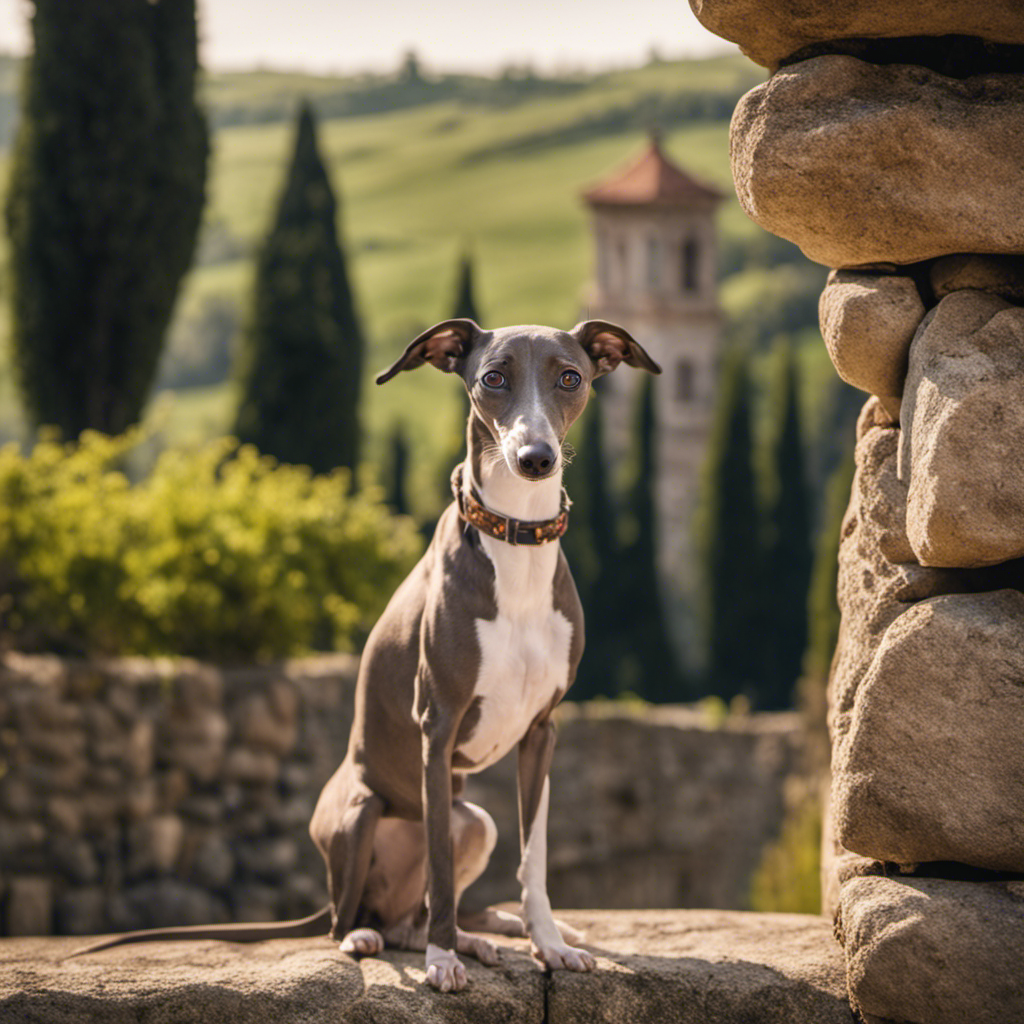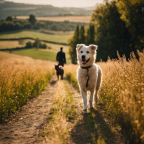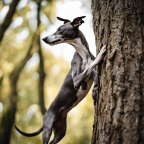- Key Takeaways
- The Importance of Teaching Your Dog the Command 'Aspetta
- Basic Steps to Start Training 'Aspetta' With Your Dog
- Tips for Reinforcing the 'Aspetta' Command in Different Environments
- Common Challenges and How to Overcome Them When Teaching 'Aspetta
- Building on 'Aspetta': Advanced Applications and Commands
- Incorporating 'Aspetta' Into Everyday Situations and Activities
- Troubleshooting: Dealing With Reluctant or Unresponsive Dogs During 'Aspetta' Training
Click and GO TO THE BEST DOG NAME GENERATOR HERE

Are you tired of your dog constantly rushing ahead or getting impatient? Teach them the command ‘Aspetta’!
In this article, you’ll discover the importance of this Italian dog command and how it can transform your dog’s behavior.
With easy-to-follow steps and helpful tips, you’ll learn how to train ‘Aspetta’ in various environments.
Plus, we’ll explore advanced applications and incorporating it into everyday situations.
Say goodbye to unruly behavior and hello to a well-behaved furry companion!
- Key Takeaways
- The Importance of Teaching Your Dog the Command 'Aspetta
- Basic Steps to Start Training 'Aspetta' With Your Dog
- Tips for Reinforcing the 'Aspetta' Command in Different Environments
- Common Challenges and How to Overcome Them When Teaching 'Aspetta
- Building on 'Aspetta': Advanced Applications and Commands
- Incorporating 'Aspetta' Into Everyday Situations and Activities
- Troubleshooting: Dealing With Reluctant or Unresponsive Dogs During 'Aspetta' Training
Key Takeaways
- Teaching ‘Aspetta’ promotes discipline, patience, and self-control in dogs.
- ‘Aspetta’ helps prevent lunging at food, stealing from the table, and ensures safety when exiting doors or cars.
- Training ‘Aspetta’ improves focus, obedience skills, and strengthens the bond between owner and dog.
- Patience can be taught by consistently reinforcing waiting, gradually increasing wait time, and practicing in real-life scenarios.
The Importance of Teaching Your Dog the Command ‘Aspetta
You should prioritize teaching your dog the command ‘aspetta’ as it promotes discipline and patience. Teaching patience is an essential aspect of dog training as it helps your furry friend develop self-control and better behavior. ‘Aspetta,’ which means ‘wait’ in Italian, is a powerful command that teaches your dog to pause and remain still until given further instructions. This command can have numerous benefits in your daily life with your dog.
One of the main benefits of teaching ‘aspetta’ is that it helps prevent your dog from rushing out of doors or jumping out of the car before it’s safe. By teaching your dog to wait, you can ensure their safety and the safety of others. Additionally, ‘aspetta’ can be useful during mealtime, preventing your dog from lunging at their food or stealing from the table.
Furthermore, incorporating ‘aspetta’ into your daily routine can also help with impulse control. It teaches your dog to resist distractions and wait patiently, which can be beneficial in various situations, such as when encountering other dogs or when waiting for their turn at the vet’s office.
Basic Steps to Start Training ‘Aspetta’ With Your Dog
To start training your dog to wait, begin by choosing a quiet, distraction-free environment. Use a treat or toy to get your dog’s attention and then say ‘Aspetta’ in a clear and firm voice.
As your dog starts to understand the command, gradually increase the duration of the wait time.
Teaching Patience Effectively
Start by consistently reinforcing the concept of waiting during training sessions for teaching patience effectively. This is crucial in teaching impulse control to your dog. By incorporating the command ‘aspetta’ in public places, you can further reinforce this skill.
Here are some key points to consider when teaching patience to your dog:
-
Consistency: Ensure that you consistently reinforce the concept of waiting during training sessions. This will help your dog understand that patience is expected in various situations.
-
Rewards: Reward your dog for practicing patience. This can be done through treats, praise, or a combination of both. Positive reinforcement will encourage your dog to exhibit patience more often.
-
Gradual Increase: Start by asking your dog to wait for short periods and gradually increase the duration. This will help them build their patience over time.
-
Real-Life Scenarios: Practice patience in real-life scenarios such as waiting at doorways, during mealtime, or when encountering distractions. This will help your dog generalize the concept of waiting to different situations.
Building Obedience and Focus
When building obedience and focus with your dog, it’s important to consistently reinforce the command ‘aspetta’ in various training sessions.
Aspetta, meaning ‘wait’ in Italian, is a powerful tool for building focus and improving impulse control in your furry companion. By teaching your dog to wait patiently, you’re helping them develop self-control and learn to resist immediate gratification.
Start by introducing the command in a controlled environment and gradually increase distractions to challenge their focus. Practice ‘aspetta’ during mealtimes, walks, and when greeting guests to reinforce the behavior in different scenarios.
As your dog becomes more proficient, you can incorporate ‘aspetta’ into practical applications in training, such as waiting at doorways or before crossing the street.
Practical Applications in Training
You can reinforce the command ‘aspetta’ by consistently practicing it in different scenarios, such as during mealtimes and when greeting guests, and gradually increasing distractions to challenge your dog’s focus. This command has practical applications in real life scenarios, helping to keep your dog safe and well-behaved in various situations.
Here are some training techniques for different breeds and temperaments:
- Start with short durations and gradually increase the time your dog needs to wait.
- Use positive reinforcement, such as treats or praise, to reward your dog for waiting patiently.
- Practice ‘aspetta’ in different environments to generalize the command.
- Be consistent with your cues and body language to help your dog understand what’s expected.
Tips for Reinforcing the ‘Aspetta’ Command in Different Environments
Try using different distractions in various locations to further reinforce the ‘aspetta’ command with your dog. When training your dog to wait or ‘aspetta’ in outdoor settings, it’s important to expose them to different environments and distractions. Start by practicing in a quiet outdoor area, such as your backyard, where there are minimal distractions. Once your dog is comfortable with the command in this setting, gradually increase the level of distractions. Take them to a park or a busy street where there are people, other dogs, and various noises. This will help your dog generalize the ‘aspetta’ command and learn to ignore distractions.
When training ‘aspetta’ with multiple dogs, it’s essential to teach each dog individually before practicing with them as a group. Begin by training one dog at a time until they fully understand the command. Once each dog is proficient, you can start practicing with them together. Keep in mind that dogs may compete for attention or get distracted when trained in a group. Be patient and consistent, rewarding each dog individually for following the ‘aspetta’ command.
Remember to use positive reinforcement techniques such as treats and praise to reward your dog’s desired behavior. Consistency is key when training your dog, so make sure to practice the ‘aspetta’ command regularly in different outdoor settings and with multiple dogs. With time, patience, and consistency, your dog will become proficient in waiting on command, regardless of the distractions or the number of dogs present.
Common Challenges and How to Overcome Them When Teaching ‘Aspetta
Teaching your dog the command ‘Aspetta’ can come with its own set of challenges. One common challenge is distractions during training. Dogs can easily get distracted by noises, smells, or other animals, making it difficult for them to focus on the command.
To overcome this, it’s important to start training in a quiet and familiar environment, gradually introducing distractions as your dog becomes more proficient. Reinforcing the command consistently and using positive reinforcement techniques will also help your dog understand and follow the ‘Aspetta’ command effectively.
Distractions During Training
Don’t let your dog’s barking become a distraction during training by rewarding their focus on ‘aspetta’. Dealing with distractions is an important aspect of maintaining focus in training sessions. Here are some tips to help you overcome distractions and keep your dog engaged:
-
Use positive reinforcement: Reward your dog with treats or praise when they successfully ignore distractions and focus on ‘aspetta’.
-
Start with low-level distractions: Begin your training in a quiet environment and gradually introduce distractions, such as toys or other people, to help your dog build their focus.
-
Increase the difficulty gradually: Once your dog can maintain focus in the presence of mild distractions, gradually increase the level of distractions to challenge their focus.
-
Be patient and consistent: Training takes time and practice. Be patient with your dog and consistently reinforce their focus on ‘aspetta’ to help them overcome distractions.
Reinforcing the Command
To reinforce the command ‘aspetta’ effectively, consistently practice with your dog every day and use positive reinforcement techniques.
Repetition is key when teaching your dog any command, and ‘aspetta’ is no exception. Start by giving the command and then use rewards and positive reinforcement when your dog follows it. This can be in the form of treats, praise, or even playtime.
By associating the command with positive experiences, your dog will be more motivated to listen and obey. Remember to be patient and consistent during the training process.
With time and practice, your dog will become proficient in ‘aspetta’ and will be able to wait patiently in various situations.
Building on ‘aspetta’, you can then move on to advanced applications and commands, expanding your dog’s obedience skills.
Building on ‘Aspetta’: Advanced Applications and Commands
Can you show me how to use ‘Aspetta’ in more advanced applications and commands?
Aspetta, which means ‘wait’ in Italian, is a fundamental command that can be built upon to enhance your dog’s training. By introducing more advanced applications and commands, you can further improve your dog’s obedience and self-control in various situations.
Here are four ways you can take ‘Aspetta’ to the next level:
-
Training with distractions: Practice ‘Aspetta’ in environments with increasing distractions, such as busy parks or crowded streets. This will teach your dog to remain focused and wait patiently, even when there are other people, animals, or noises around.
-
Extended duration: Gradually increase the duration of ‘Aspetta’ by asking your dog to wait for longer periods of time. This can be particularly useful in situations where you need your dog to hold a position while you attend to something else.
-
Distance control: Teach your dog to wait at a distance from you, gradually increasing the distance between you and your dog. This is helpful for situations when you want your dog to wait at a certain spot without you being right next to them.
-
Release cue: Introduce a specific cue that signifies the end of the wait, such as ‘okay’ or ‘go’. This will let your dog know when it’s time to move or continue with the next command.
Incorporating ‘Aspetta’ Into Everyday Situations and Activities
How can you effectively incorporate ‘Aspetta’ into everyday situations and activities, such as mealtime and going for walks? Training your dog to wait, or ‘aspetta’ in Italian, can be a useful command in various situations. By incorporating ‘aspetta’ into mealtime and walks, you can teach your dog patience and impulse control. During mealtime, use the command to instruct your dog to wait patiently until you give them permission to eat. This can prevent them from begging or rushing towards their food. Similarly, during walks, ‘aspetta’ can be used to teach your dog to wait before crossing the street or approaching other dogs or people. This ensures their safety and promotes good behavior.
To help you visualize the incorporation of ‘aspetta’ into everyday situations, here is a table showcasing some ideas:
| Situation | How to incorporate ‘Aspetta’ |
|---|---|
| Mealtime | Command your dog to wait before eating until you give them permission. |
| Walks | Use ‘aspetta’ to teach your dog to wait before crossing the street or approaching other dogs or people. |
| Doorways | Train your dog to wait before entering or exiting a room or building. |
Troubleshooting: Dealing With Reluctant or Unresponsive Dogs During ‘Aspetta’ Training
You may encounter some challenges when dealing with reluctant or unresponsive dogs during ‘aspetta’ training, but with patience and consistency, you can overcome them.
Dealing with stubborn dogs can be frustrating, but it’s important to remember that every dog is unique and learns at their own pace.
Here are some tips to help you navigate through these challenges using positive reinforcement techniques:
-
Stay calm and patient: Dogs can sense your frustration, so it’s important to remain calm and composed during training sessions. Take breaks if needed and approach the training with a positive mindset.
-
Break it down: If your dog is struggling with the ‘aspetta’ command, break it down into smaller steps. Start by teaching them to sit and stay before gradually introducing the ‘aspetta’ command.
-
Use high-value rewards: Find treats or toys that your dog absolutely loves and use them as rewards during training. Positive reinforcement will motivate your dog to respond to the ‘aspetta’ command.
-
Consistency is key: Practice the ‘aspetta’ command regularly and make sure everyone in the household is on the same page. Dogs thrive on routine and consistency, so stay committed to the training process.
- Key Takeaways
- The Importance of Teaching Your Dog the Command 'Aspetta
- Basic Steps to Start Training 'Aspetta' With Your Dog
- Tips for Reinforcing the 'Aspetta' Command in Different Environments
- Common Challenges and How to Overcome Them When Teaching 'Aspetta
- Building on 'Aspetta': Advanced Applications and Commands
- Incorporating 'Aspetta' Into Everyday Situations and Activities
- Troubleshooting: Dealing With Reluctant or Unresponsive Dogs During 'Aspetta' Training


